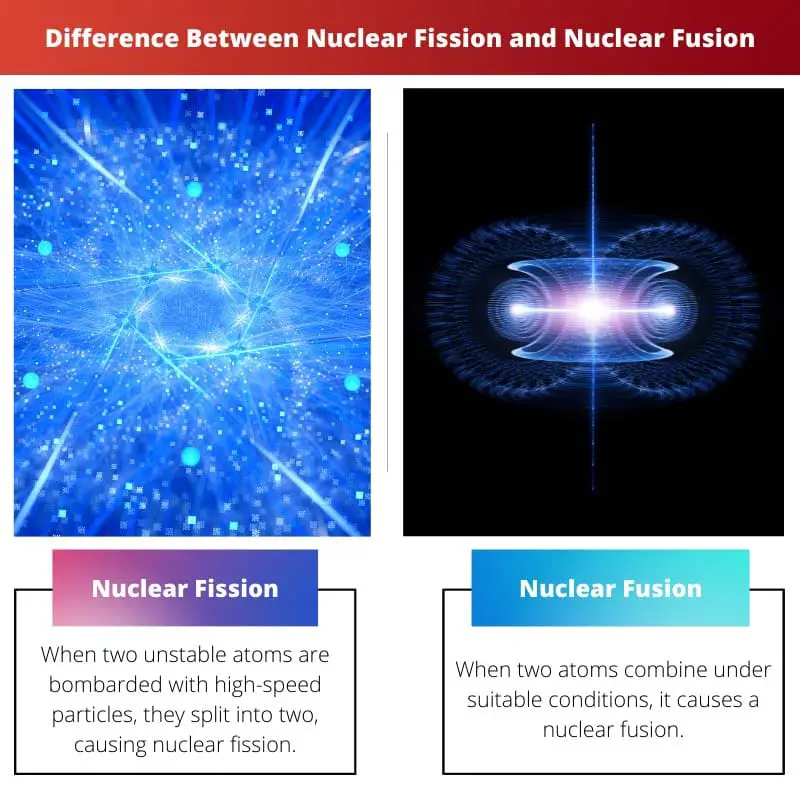Nuclear reactions can be of two types. First nuclear fission and second nuclear fission. Both of these reactions are high-energy-yielding reactions.
Key Takeaways
- Nuclear fission involves splitting atomic nuclei, while nuclear fusion combines them.
- Fission generates radioactive waste, whereas fusion produces minimal radioactive byproducts.
- Fusion requires extremely high temperatures to initiate, while fission occurs more easily under controlled conditions.
Nuclear Fission vs Nuclear Fusion
Nuclear fission is the type of nuclear reaction in which a large, unstable atom breaks into smaller, stable atoms. This term was defined by Neither Hann and Fritz. Nuclear fusion is the kind of nuclear reaction in which two small, unstable atoms fuse or combine with one another to form a large, stable atom. This term was formed by Rutherford, Edington and Einstein.

Nuclear fission is a type of nuclear reaction in which a heavy atom that is unstable in energy breaks into two or smaller atoms with comparatively stable energy due to either internal factors or external factors
like bombarding with high-energy beams or any such measures.
Nuclear fusion is a type of nuclear reaction in which two or more light atoms are combined with one another to form a larger atom with comparatively stable energy.
Comparison Table
| Parameters of Comparison | Nuclear Fission | Nuclear Fusion |
|---|---|---|
| Meaning | When two unstable atoms are bombarded with high-speed particles, they split into two, causing nuclear fission. | When two atoms combine under suitable conditions, it causes a nuclear fusion. |
| Reactant | One heavy mass radioactive isotope is the sole reactant of fusion. | Two low mass isotopes are the starting reactant of nuclear fusion. |
| Product | Two smaller isotopes are created as a result of the division of the nucleus. | One large isotope is created as a result of combining the nucleus. |
| Energy Release | Less energy is released compared to nuclear fusion. | More energy is released compared to nuclear fission. |
| Harnessing | Fission is a controlled phenomenon, and hence the energy can be harnessed. | Nuclear fusion energy cannot be harnessed. |
What is Nuclear Fission?
Nuclear fission, coined and discovered by Neither Hann and Fritz, is a reaction in which a large atom is energetically unstable, which means it has a large of protons in comparison to neutrons,
and this atom is also an isotope, meaning it has other atoms with the same number of protons but a different number of neutrons split into two smaller atoms due to the division of the nucleus.
Usually, initial energy is provided to kick start the reaction by bombarding the nucleus with high-speed particles, after which the reaction continues unhindered by itself until the atoms cannot split into further smaller atoms.
Nuclear fission luckily is a more controlled form of nuclear reaction as it halts after a certain time, and this energy released is successfully harnessed in nuclear reactors.
However, radioactive waste is produced in large amounts, and the process also eliminates harmful radioactive rays unsuitable for animal or plant contact, and this must be done under very regulated conditions.
What is Nuclear Fusion?
Nuclear fusion is a type of chemical reaction studied by various scientists like Rutherford, Edington, Einstein and so on.
It is a reaction in which two smaller energetically unbalanced atoms or isotopes combine to form one large atom or isotope of an atom.
The surface of the Sun is the best example of an all-time occurring nuclear fusion as the temperature and pressures on the surface of the Sun are suitable for nuclear fusion to occur.
Nuclear fusion emits a large amount of energy, a by-product of the reaction; however, the energy is too large to be harnessed or controlled, and hence, there are no nuclear reactors on Earth that support a nuclear fusion reaction.
The combination of Deuterium and Tritium to form Helium is a good example of nuclear fusion.
Main Differences Between Nuclear Fission and Nuclear Fusion
- Nuclear fission takes place on large-sized heavy atoms, whereas nuclear fusion combines two small-sized light atoms to make a heavy one.
- Nuclear fission can be controlled, whereas nuclear fusion cannot be controlled, and hence, there are no nuclear reactors for nuclear fusion in the world.

- https://journals.aps.org/pr/abstract/10.1103/PhysRev.56.426
- https://www.sciencedirect.com/science/article/pii/S0920379610005119

Great to learn about the discovered of nuclear fission and fusion
Nuclear fission and fusion are complex concepts, this article did a good job explaining them
The information on the difference between nuclear fission and nuclear fusion was well explained
I liked the references provided at the end, the scientific sources add credibility to the article
I appreciate the detailed explanation of nuclear fusion, it’s a fascinating topic
Nuclear reactions are a very interesting subject and an important topic to understand
I found this article very informative, it helped me understand the differences between nuclear fission and fusion
The comparison table was very helpful, providing a clear distinction between nuclear fission and nuclear fusion